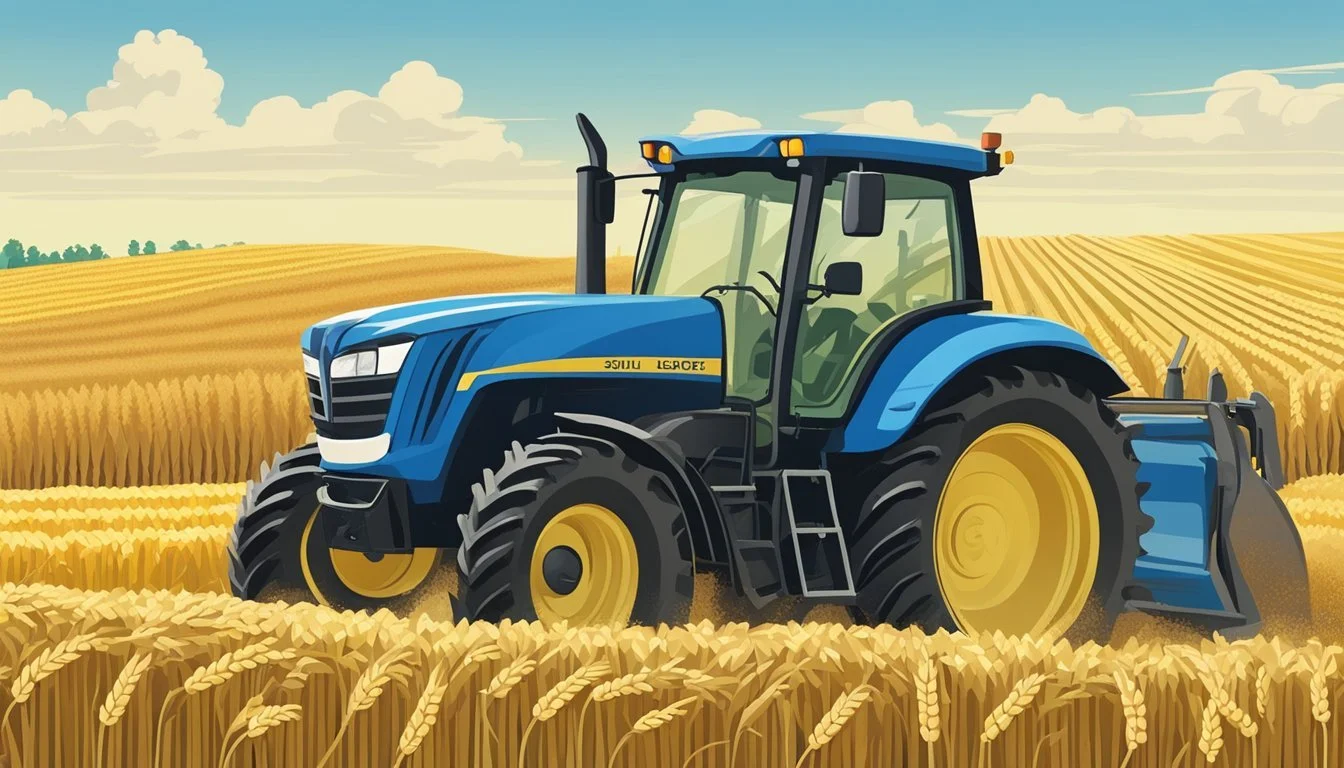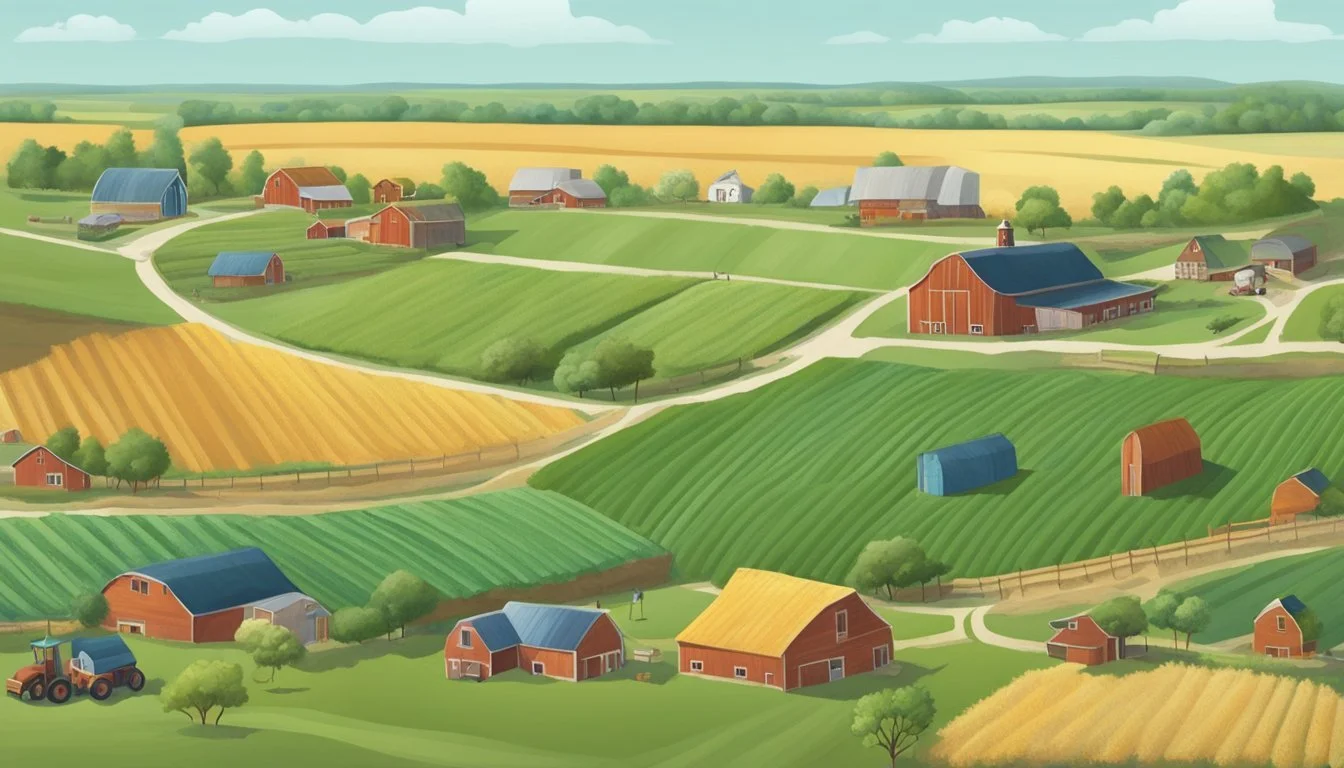Farming Communities in Kansas
Thriving Agricultural Hubs
Kansas is home to a rich tapestry of farming communities that are vital to both local and national agriculture. These communities consist of dedicated farmers who cultivate a vast array of crops and livestock, contributing significantly to the state's economy. Kansas farms and ranches span thousands of acres, offering a diverse range of agricultural opportunities from wheat and corn fields to cattle ranches.
In these farming communities, agriculture is not just a job; it is a way of life passed down through generations. The land, worked by families who have maintained it for decades, provides a strong sense of identity and purpose. Neighbors collaborate, share resources, and support one another, creating a close-knit community that thrives on mutual aid and agricultural expertise.
Kansas's farming communities benefit from modern agricultural practices while preserving traditional methods. The state's expansive farmlands can be found dotted with advanced farming equipment, alongside fields harvested by hand. This blend of the old and the new ensures that Kansas remains a leading agricultural producer while fostering sustainable and responsible farming practices.
History of Farming in Kansas
Kansas farming communities have a rich legacy shaped by pioneers and significant agricultural development. From early settlers in Eastern Kansas to the transformation of prairie land into fertile farmland, the evolution of agriculture has been central to the region's identity.
Settlement and Expansion
In the 19th century, Kansas saw a significant influx of pioneers eager to start new lives. The Homestead Act of 1862 played a crucial role, granting settlers over 100 acres of land to cultivate.
Eastern Kansas was one of the first areas to attract these settlers due to its fertile soil and accessible location. New towns and post offices quickly sprang up, providing essential services and fostering community growth.
Western Kansas, despite its challenges, saw a slower but steady settlement wave. Pioneers here had to contend with harsher conditions and a more arid climate. Yet they persevered, turning prairie land into productive farmland.
Agricultural Development
By the late 19th and early 20th centuries, Kansas became known as the "Wheat State" and the "Breadbasket of the World," thanks to its booming wheat production. Farmers in Kansas adapted to new technologies, including steel plows and mechanized harvesters, to increase efficiency.
Family farms dominated the landscape, often passed down through generations and playing a critical role in the local economy. The introduction of drought-resistant crops helped mitigate some of the harsher environmental challenges faced by Western Kansas farmers.
The state's agricultural legacy continues to impact its economy, politics, and social customs. The interconnected efforts of Kansas farmers, county agents, and farm bureaus have been pivotal in maintaining Kansas's status as a major agricultural hub in the U.S.
Geography and Environment
Kansas' diverse geography and environment play a crucial role in shaping its farming communities. From the unique Flint Hills to the extensive High Plains, these regions influence soil health, water quality, and local ecosystems.
The Flint Hills and High Plains
The Flint Hills, located in the eastern part of the state, are known for their tallgrass prairie and rolling hills. This region supports a rich biodiversity and sustains cattle ranching due to the extensive grasslands. Soil health is preserved by the native grasses, promoting strong root systems that prevent erosion.
In contrast, the High Plains, found in western Kansas, feature flat terrains and extensive agricultural activities. This area is vital for crop cultivation, primarily wheat and sorghum. The ecosystem here is adapted to less precipitation, making irrigation crucial for soil health and high crop yields.
Climate and Weather Conditions
Kansas experiences a continental climate with hot summers and cold winters. Weather conditions fluctuate, impacting farming practices. In the eastern parts, more rainfall supports diverse crops and robust water quality, while the drier west relies on significant irrigation.
Climate change poses challenges, such as increased temperature and changing precipitation patterns. Farmers are adapting by integrating drought-resistant crops and efficient water management techniques. These efforts aim to mitigate adverse environmental impacts and sustain productivity amidst ever-evolving weather conditions.
Enduring unpredictable weather, Kansas' farming communities continue to evolve, proving their resilience and commitment to sustainable practices.
Farming Practices in Kansas
Kansas agriculture is characterized by diverse and sustainable practices aimed at maximizing productivity and maintaining ecological health. The main practices include sophisticated cropping systems and thorough livestock management techniques.
Cropping Systems and Rotation
Farmers in Kansas employ crop rotation and cover crops to maintain soil fertility and reduce pest infestations. Wheat and corn are primary crops, rotated with sorghum and sunflowers to prevent soil depletion.
Sustainable farming practices, like using legumes to enrich the soil with nitrogen, are common. Conservation practices, such as no-till farming, help minimize erosion and water loss. These techniques collectively enhance the long-term productivity and health of the farmland.
Livestock Management
Livestock farming, an integral part of Kansas agriculture, involves careful management to ensure animal health and environmental sustainability. Cattle ranching predominates, with practices including rotational grazing to prevent overgrazing and promote pasture regeneration.
Sustainable agriculture practices are implemented to reduce the environmental footprint. These include using feed that minimizes methane emissions and ensuring proper waste management to avoid water contamination. Emphasis is placed on maintaining ethical standards in animal welfare, adding a socially responsible dimension to Kansas livestock management.
Economic Aspects and Growth
The farming communities in Kansas form a significant backbone of the state's economy, contributing to both production and employment. This section examines market trends, family farms, and key agricultural policies driving growth and economic viability.
Market Analysis and Trends
Kansas generated around $24.6 billion in agricultural cash receipts in 2022. The primary commodities include cattle, corn, and wheat, which are central to Kansas's agricultural strength.
Markets for these commodities remain robust, driven by both domestic demand and international exports. The economic influence extends beyond the farms, impacting agricultural processing and support industries.
In terms of GDP contribution, agriculture represented 6.5% of the state's total output. This data underscores the sector's critical role in economic stability and growth. Changing weather patterns and technological advancements also significantly impact productivity and market conditions.
Role of Family Farms
Family farms are the cornerstone of Kansas agriculture, contributing notably to production and economic viability. These farms often pass down through generations, ensuring continuity and skill retention within the community.
Family farms account for a majority of the state’s agricultural activities, playing a vital role in maintaining the rural economy and local employment.
Agricultural policies designed to support family farms, such as subsidies and tax incentives, are crucial to their sustainability. Such policies also encourage younger generations to continue farming, thereby securing future growth and stability.
The next generation is essential to keep these farms operational, as they bring innovations and new practices to traditional farming methods.
Community and Rural Life
Rural Kansas exemplifies a unique blend of tight-knit communities and evolving infrastructure. Small town dynamics influence social interactions and local economies, while educational resources drive community growth and sustainability.
Small Town Dynamics
In rural Kansas, small town life revolves around Main Street, the heart of many communities. These towns often boast few residents, fostering strong interpersonal relationships and a sense of belonging.
Community events play a vital role, bringing people together through fairs, parades, and local festivals, reinforcing social bonds. Local businesses thrive on communal support, contributing to the town's economy.
Residents in these rural areas typically have a deep connection to the land and a shared history. Infrastructure projects, like those supported by the Kansas Rural Center, aim to sustain and revitalize these communities. Investment in new facilities, broadband internet, and healthcare access shows a commitment to improving quality of life.
Educational and Information Resources
Education is seen as essential for the future of rural communities in Kansas. Schools act as community hubs, often doubling as information centers.
Libraries and extension services provide educational resources and support lifelong learning. The Kansas Rural Center promotes agricultural research and education to ensure farmers and their families can manage and improve their operations efficiently.
Internet access has become a critical factor in modern education. Grants and initiatives, such as those from the USDA, aim to expand high-speed internet in rural areas, enabling access to online courses, remote learning opportunities, and valuable information resources that are crucial in today's digital age.
Sustainability and the Future
Farming communities in Kansas are focusing on implementing sustainable and regenerative farming practices to ensure long-term agricultural productivity. Emphasizing both the improvement of soil health and adaptation strategies to counter the impacts of climate change are crucial for the region.
Sustainable and Regenerative Techniques
Regenerative agriculture involves practices that restore and maintain soil health, which is fundamental for sustainable farming. Techniques such as crop rotation, cover cropping, and reduced tillage are commonly employed. These methods enhance soil structure, increase biodiversity, and reduce erosion. Kansas Farm Bureau (KFB) highlights the significance of such systems in minimizing environmental footprints while increasing soil productivity.
Diversifying crops, incorporating sorghum, rye, oats, and millet, has shown to use less water, a critical consideration for Kansas' water-scarce environment. According to recent studies, this diversity improves the nutritional yield per acre and reduces reliance on water-intensive crops. This strategic mix supports the state's goals for sustainable agriculture, enhancing resilience against climate variabilities.
Adapting to Climate Change
Kansas' agriculture sector must address the challenges posed by climate change, such as unpredictable weather patterns and extreme temperatures. Greg Krissek, CEO of Kansas Corn, underscores the need for adaptive strategies including technological innovations.
Projects aimed at climate resiliency are underway, focusing on water management and crop selection. Advanced irrigation technologies and drought-resistant crop varieties are being developed to mitigate potential yield losses.
Advocacy plays a key role in this transition, pushing for policies that support sustainable farming practices and address the broader impacts of climate change. Through concerted stewardship efforts, Kansas is working towards a more climate-resilient agricultural future.
Government and Organization Support
Farming communities in Kansas benefit from various government and organizational initiatives that enhance agricultural practices and support rural livelihoods. These efforts include state-led initiatives and collaborative community projects, focusing on economic viability, environmental stewardship, and resource management.
Kansas Department of Agriculture Initiatives
The Kansas Department of Agriculture (KDA) plays a crucial role in supporting the agricultural sector. It provides research and advocacy to ensure sustainable farming practices and economic growth. Initiatives such as water resource management and conservation efforts are key areas of focus.
Programs like the Conservation Reserve Program-Transition Incentives Program, administered in partnership with institutions like Kansas State University, promote awareness and technical assistance. These programs aim to educate farmers about environmentally sound practices, ensuring long-term agricultural sustainability.
Partnerships and Community Projects
Various community projects and partnerships further bolster support for Kansas farming communities. The Kansas Rural Center (KRC) leads several initiatives aimed at fostering economic viability and social justice in agriculture.
KRC's projects, including research and educational programs, target sustainable farming methods and ecologically sound practices. Additionally, federal grants and resources support rural development. For instance, USDA's financial investments in Kansas communities aim to create high-wage jobs and accelerate new business formation, enhancing rural economies.
Through these collaborative efforts, farming communities receive the necessary tools and knowledge to thrive both economically and environmentally.
Diversified Farming and Economic Strategies
In Kansas, integrating diversified farming systems with innovative infrastructure and development is vital for economic viability and sustainable agriculture.
Integrating Diversified Crop and Livestock Systems
Diversified farming in Kansas incorporates various crops and livestock, enhancing soil health and economic resilience.
Farmers often rotate crops like wheat, sorghum, and sunflowers to maintain soil fertility. This practice reduces dependency on a single crop and mitigates risks from market fluctuations and climate change.
Cattle ranching coexists with crop cultivation, utilizing crop residues as fodder and returning nutrients to the soil through manure. This synergy supports sustainable agriculture, balancing economic and environmental needs. Farmers aim for long-term growth by blending these practices, ensuring robust rural economies.
Innovation and Infrastructure Development
Innovation in farming methods and infrastructure development are critical drivers for the success of diversified farming systems.
Advancements in agricultural technology like precision farming improve crop yields and water efficiency. Kansas farmers adopt smart irrigation systems and remote sensing to optimize resources.
Enhancing infrastructure, such as storage facilities and transportation networks, reduces waste and increases market access. Public and private investments in these areas create a more resilient agricultural economy.
Emerging practices and infrastructure improvements make Kansas a leading example of how to combine technology and traditional farming wisdom for a sustainable and prosperous future.
Health and Food Systems
Farming communities in Kansas are deeply connected to health and food systems. They play a significant role in ensuring access to healthy food choices and in promoting nutritional education and public health.
Access to Healthy Food Choices
Kansas farming communities are instrumental in providing access to locally grown, healthy food. Through initiatives like the Kansas Rural Center, efforts are made to promote an economically viable, ecologically sound, and socially just food system.
Farm-to-fork programs are key in providing fresh, local produce to residents. These programs often involve Food and Farm Councils, mobilizing communities to support and distribute healthy local foods.
Efforts are also made to address food deserts by establishing farmers' markets and local food hubs in underserved areas. These measures help improve food security and quality, directly impacting public health.
Nutritional Education and Public Health
Educational programs in Kansas emphasize the importance of nutritional awareness among farming communities. Organizations like the Kansas Local Food Systems contribute to building community resilience by teaching sustainable farming practices.
Workshops and seminars conducted by these organizations provide vital information on subjects such as organic farming, healthy eating habits, and stress management.
Public health initiatives also include collaborations with entities like universities and public health centers. These collaborations aim to educate about the long-term benefits of consuming locally produced, nutritious food.
Investing in nutritional education helps build a well-informed public that values healthy food choices, leading to better health outcomes in these communities.
Legal and Ethical Considerations
Farmers in Kansas face significant legal and ethical challenges. These include the stewardship of land and the intricacies of intellectual property rights.
Land Stewardship and Ownership Rights
Land stewardship is a fundamental aspect of farm policy in Kansas. Many family farms view their land as a legacy, emphasizing sustainable practices to ensure its viability for future generations. Stewardship involves balancing productivity with environmental impacts.
Ownership rights often come into play, particularly when legacy lands transfer between generations. Disputes can arise regarding land use and conservation practices. Ethical considerations also include ensuring access to resources for smallholders and protecting land from industrial overuse.
Intellectual Property and Creative Commons
The rise of smart farming technologies introduces complexities in intellectual property. Kansas farmers often rely on patented technologies for improved productivity. However, the legal landscape surrounding these technologies can be difficult to navigate.
Creative Commons licenses offer an alternative, promoting sharing and innovation. These licenses facilitate the dissemination of farming innovations without infringing on proprietary rights. This approach can democratize access to advanced farming methods, particularly benefiting smaller farms.









